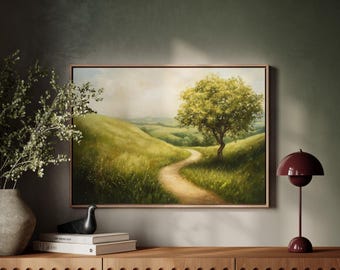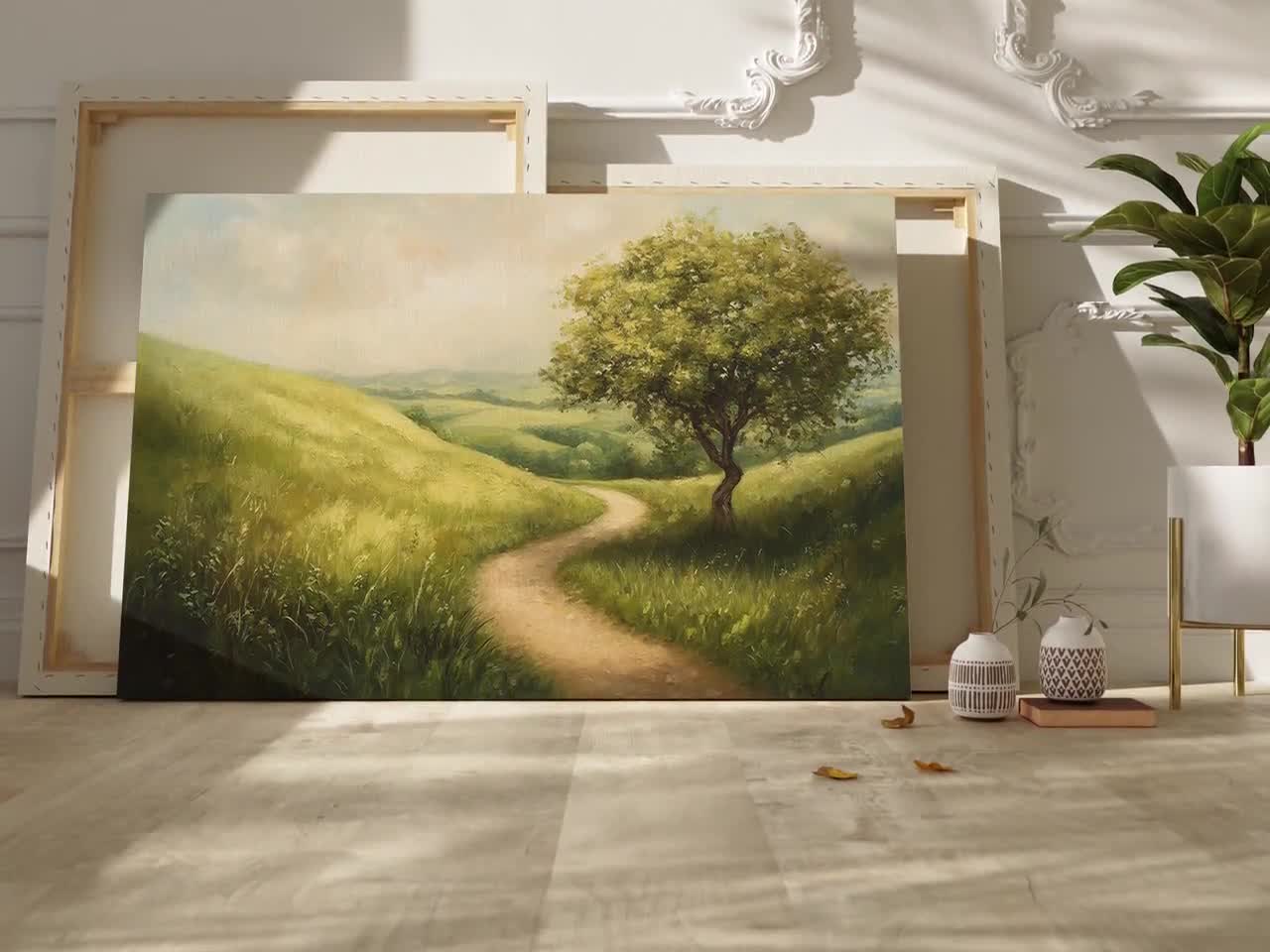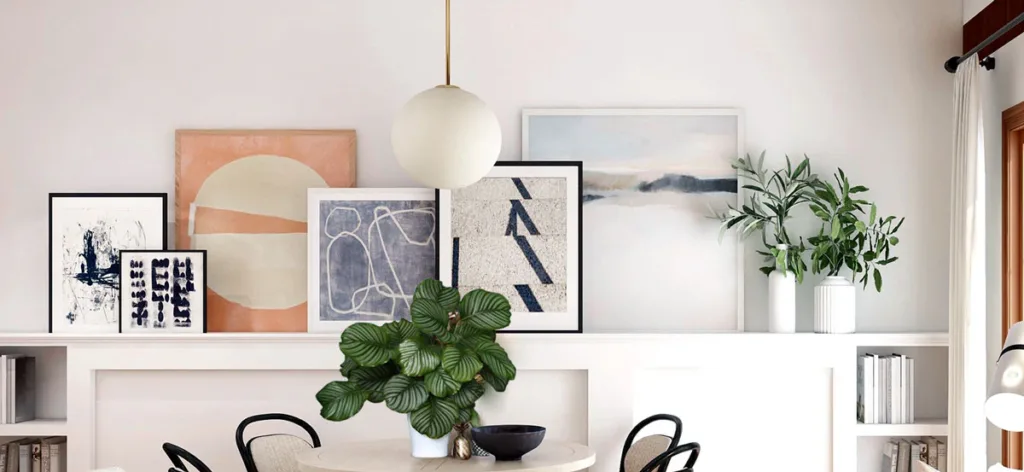News
Serene Horizons: Enriching Spaces with Countryside Landscape Art
Part 1: The Allure and Emotional Power of Countryside Landscape Art
Countryside landscape art possesses a timeless charm that transcends mere decoration. These serene depictions of rolling hills, quaint farmhouses, meandering trails, and blooming fields evoke nostalgia, tranquility, and a deep connection with nature. Unlike urban or abstract art, countryside landscapes bring a sense of space, openness, and grounding, offering both visual pleasure and emotional solace. In a world dominated by fast-paced routines and technology, these artworks invite viewers to pause, breathe, and reflect, creating interiors that feel welcoming, peaceful, and alive with story.
1. Historical and Cultural Significance of Countryside Landscapes
The fascination with rural landscapes has deep roots in art history. From classical oil paintings to contemporary watercolors, artists have long turned to the countryside for inspiration, symbolism, and aesthetic beauty.
European Tradition: During the Renaissance and later Romantic periods, European painters celebrated rural life as an idealized space of harmony and natural beauty. Artists like Claude Lorrain, John Constable, and Camille Corot captured pastoral scenes with an emphasis on light, atmosphere, and emotional resonance, portraying cottages, rivers, and farmland with meticulous attention to detail.
American Landscapes: In the 19th century, the Hudson River School and other American artists highlighted the vastness and grandeur of rural landscapes. Their works conveyed a sense of freedom, exploration, and respect for nature, emphasizing wide horizons, open skies, and lush fields.
Asian Interpretations: In traditional Chinese and Japanese art, landscapes often include countryside elements—mountains, rivers, rural villages, and fields—rendered with careful brushwork and poetic subtlety. These depictions emphasize balance, harmony, and connection between humans and nature, influencing contemporary landscape aesthetics globally.
Across cultures, countryside landscapes have symbolized simplicity, continuity, and rootedness, providing visual narratives that resonate with personal and collective memory. They remind viewers of natural cycles, human ingenuity in harmony with land, and the beauty of everyday rural life.
2. Emotional and Psychological Benefits
Countryside landscapes have a remarkable ability to influence mood, stress levels, and overall well-being.
Stress Reduction: Viewing rural scenes, whether a quiet farm at sunrise or a golden wheat field under a vast sky, triggers relaxation and calm. Research shows that nature imagery reduces stress hormones, lowers blood pressure, and promotes mental clarity.
Nostalgia and Memory: Countryside scenes often evoke personal memories or a sense of cultural heritage. Whether recalling a family visit to the countryside, childhood adventures, or romanticized rural ideals, these works connect viewers to their past, fostering emotional warmth and reflection.
Inspiration and Creativity: Open landscapes, expansive skies, and winding paths stimulate imagination. They encourage daydreaming, artistic thought, and introspection, making them ideal for creative spaces such as studios, offices, or reading nooks.
Mindfulness and Presence: Rural imagery invites viewers to slow down and appreciate the details—the texture of grass, the play of light on water, or the pattern of trees. This mindfulness enhances emotional balance, encourages gratitude, and strengthens the sense of connection with the natural world.
By incorporating countryside landscapes into interiors, homeowners create environments that nurture both the mind and the spirit, providing beauty and tranquility alongside practical functionality.
3. Aesthetic Principles in Countryside Landscape Art
Successful countryside landscape art engages the viewer through composition, color, perspective, and mood.
Composition and Focal Points: Artists carefully arrange elements—trees, rivers, pathways, cottages—to guide the eye through the scene. Leading lines, horizon placement, and foreground-background contrast create depth and invite visual exploration.
Color Harmony: Earthy tones, greens, blues, and warm pastels evoke calm and realism. Color palettes may reflect the season—vivid autumn hues, soft spring pastels, or sunlit summer fields—enhancing emotional resonance.
Light and Atmosphere: Mastery of lighting is central to countryside art. Golden hour sun, misty mornings, or diffused overcast skies add drama, serenity, or romanticism, capturing both mood and time of day.
Perspective and Depth: The illusion of three-dimensional space draws viewers into the scene. Overlapping elements, scale variation, and atmospheric perspective—where distant objects appear softer and lighter—create immersive landscapes.
Texture and Medium: Oil paints offer richness and depth; watercolors provide delicacy and transparency; acrylics allow vibrant hues and layered experimentation. Medium choice influences texture, tactile quality, and overall impact.
Movement and Flow: Subtle cues—swaying trees, rippling water, or moving clouds—introduce dynamism, making landscapes feel alive rather than static.

4. Symbolism in Countryside Landscapes
Rural landscapes convey layers of meaning, often tied to cultural, emotional, or personal significance.
Fields and Crops: Symbolize abundance, growth, and human connection to land. They evoke gratitude and the rewards of labor.
Paths and Roads: Represent journey, progress, and life’s direction. Winding trails or country lanes invite contemplation or exploration.
Farmhouses and Barns: Convey warmth, stability, and human presence amidst nature, creating a sense of belonging and homeliness.
Rivers and Streams: Reflect life’s flow, serenity, and reflection. Water adds dynamism, balance, and emotional depth.
Seasonal Cues: Blooming spring meadows symbolize renewal; autumn fields suggest reflection and maturity; winter landscapes evoke stillness and introspection.
Symbolism enhances narrative depth, allowing landscapes to function as more than visual decoration—they communicate story, sentiment, and timeless human connection with nature.
5. Types and Styles of Countryside Landscape Art
Countryside landscapes appear in a variety of styles and formats, each offering distinct aesthetic experiences:
Realistic Representations: Capture natural detail with accuracy and fidelity, suitable for classic or traditional interiors.
Impressionistic Landscapes: Emphasize light, color, and atmosphere over fine detail, providing softness and poetic mood.
Abstract Interpretations: Focus on color, shape, and emotion, translating natural forms into dynamic visual experiences. Ideal for contemporary spaces.
Watercolor Landscapes: Convey delicacy, fluidity, and serenity, perfect for bedrooms or meditation corners.
Oil and Acrylic Landscapes: Provide depth, texture, and vibrancy, making them ideal for statement pieces in living rooms or offices.
Mixed Media or 3D Elements: Incorporate layered textures, natural materials, or sculptural elements for tactile richness and creative expression.
Photography and Prints: Capture the realism and fleeting moments of rural life, offering accessibility, flexibility, and seasonal rotation opportunities.
6. Connecting Personally with Countryside Art
The most impactful landscapes are personally resonant:
Memory and Experience: Choose scenes that evoke personal experiences or emotional connections—childhood farms, familiar hiking trails, or idyllic vacations.
Mood and Atmosphere: Select landscapes that align with desired room ambiance—soft meadows for calm, golden fields for warmth, stormy skies for drama.
Symbolic Significance: Reflect on elements’ deeper meaning—paths for journeys, barns for stability, rivers for contemplation.
Narrative Potential: A series of seasonal or thematic landscapes can create a visual story, adding depth and engagement to interiors.
7. Integrating Countryside Landscapes into Interiors
Countryside landscapes can enhance virtually any décor style:
Traditional Interiors: Realistic oil paintings or classic watercolors pair beautifully with wooden furniture, warm tones, and formal layouts.
Modern Spaces: Abstract or impressionistic landscapes introduce movement, color, and dynamic focal points, contrasting minimalist furniture.
Rustic and Farmhouse Interiors: Scenes of rolling hills, farmhouses, and wildflowers blend seamlessly with natural textures and earthy palettes.
Eclectic Spaces: Mixing landscape art with other themes encourages storytelling, creativity, and layered visual interest.
Workspaces and Studios: Expansive skies, open fields, and winding trails inspire focus, clarity, and imagination.
8. Light, Space, and Perspective in Display
Placement, lighting, and perspective dramatically influence impact:
Natural Light: Enhances colors, shadows, and atmospheric effects. Golden light emphasizes warmth, while soft diffused light conveys serenity.
Accent Lighting: Picture lights, spotlights, or subtle ambient illumination highlight details and depth, creating drama or intimacy.
Scale and Spatial Awareness: Oversized landscapes create immersion; smaller pieces offer subtle charm without overwhelming. Consider furniture height, wall size, and sightlines.
Viewing Angles: Ensure key elements—horizons, focal points, and foreground features—are visible from multiple positions to maximize impact.
9. Emotional and Narrative Engagement
Countryside landscapes tell compelling visual stories:
Tranquil Meadows and Pastures: Encourage peace, relaxation, and contemplation.
Winding Trails and Waterways: Inspire reflection, curiosity, and life’s journey.
Seasonal Landscapes: Celebrate cycles of growth, change, and renewal.
Dramatic Skies and Horizons: Convey grandeur, wonder, and awe, enriching visual and emotional experience.
10. Conclusion: The Lasting Power of Countryside Landscape Art
Countryside landscape art offers timeless beauty, emotional resonance, and aesthetic versatility. It captures both nature’s majesty and human connection to the land, evoking nostalgia, serenity, and inspiration. Thoughtful selection, considering composition, color, symbolism, and personal resonance, allows landscapes to enrich interiors, uplift spirits, and create immersive visual experiences.
From a sunlit meadow painting energizing a living room, to a misty autumn trail offering calm in a bedroom, or a series of seasonal landscapes narrating the passage of time, countryside art transforms spaces into meaningful, inspiring, and serene environments. Its enduring appeal lies in the combination of visual beauty, emotional depth, and storytelling, making it an invaluable choice for homes seeking both aesthetic charm and personal connection.
Part 2: Selecting the Perfect Countryside Landscape Artwork
Choosing the perfect countryside landscape artwork is both an art and a deeply personal journey. It goes beyond mere decoration; it involves understanding your space, personal taste, emotional goals, and how the piece will interact with your interior. A carefully selected landscape can transform a room, evoke nostalgia, and create a profound sense of connection with nature. This section delves into key considerations for selecting countryside landscapes, from theme and color to scale, medium, and narrative potential.
1. Understanding Your Space
Before selecting any landscape, consider the room’s purpose, size, and existing décor:
Living Rooms: A large-scale countryside painting or panoramic view creates a focal point that energizes and anchors the space. Rolling hills, golden fields, or sunlit meadows can enhance warmth and comfort.
Bedrooms: Opt for serene, calming landscapes—soft pastels, gentle rivers, or quiet forested paths promote relaxation and reflection. Smaller artworks or grouped series work well over beds, nightstands, or reading corners.
Workspaces and Studios: Landscapes with expansive skies, winding trails, or dynamic weather patterns stimulate creativity and mental clarity. Vibrant scenes inspire energy and imaginative thought, while softer, minimalist landscapes provide balance for focus and contemplation.
Entryways and Hallways: Transitional spaces benefit from medium-sized artworks that set the tone. A rustic barn or sunlit meadow painting can greet guests and establish an inviting, harmonious ambiance.
Consider wall color, furniture placement, and natural lighting to ensure the landscape complements rather than competes with its surroundings.
2. Choosing Landscape Themes
Countryside landscapes offer a variety of thematic possibilities, each evoking unique moods and stories:
Meadows and Fields: Represent growth, abundance, and tranquility. Sunflowers, lavender, or wildflowers create vibrant, uplifting environments.
Farmhouses and Barns: Convey stability, warmth, and human connection to the land. Ideal for creating a cozy, homely atmosphere.
Rivers, Lakes, and Waterways: Symbolize reflection, serenity, and the passage of time. Water elements add depth, balance, and dynamic energy to a scene.
Woodlands and Forests: Offer mystery, depth, and natural beauty. Tall trees, dappled light, and winding paths invite introspection and exploration.
Rolling Hills and Open Horizons: Create a sense of freedom, expansiveness, and possibility, visually enlarging smaller rooms and instilling openness.
Seasonal Landscapes: Reflect nature’s cycles—spring blossoms for renewal, summer fields for vibrancy, autumn foliage for reflection, and winter snowscapes for calm and stillness.
Choosing a theme that resonates with your personal experiences or desired ambiance ensures the artwork’s lasting impact.
3. Color Palette Considerations
Color is critical in shaping mood and integrating art into interiors:
Warm Hues: Reds, golds, and yellows evoke energy, optimism, and warmth. Ideal for living areas or communal spaces.
Cool Hues: Blues, greens, and soft purples promote calm, relaxation, and introspection, perfect for bedrooms or reading nooks.
Neutral and Earthy Tones: Browns, tans, and muted greens harmonize with natural materials, wood, and rustic décor.
Seasonal Colors: Reflecting seasonal changes in palette reinforces the narrative and emotional impact of landscapes. Spring pastels suggest renewal, autumnal shades evoke nostalgia and reflection.
Contrast and Harmony: Ensure colors complement existing décor, furniture, and lighting. Bold contrast creates focal drama, while harmonious tones create cohesion and serenity.

4. Scale and Proportion
The size of a landscape dramatically affects its presence and interaction with a space:
Large Landscapes: Oversized canvases or panoramic vistas command attention, create immersive experiences, and act as conversation starters. Perfect above sofas, dining tables, or expansive walls.
Medium-Sized Works: Flexible in placement, ideal for grouped arrangements, gallery walls, or thematic collections.
Small Artworks: Provide subtle charm, intimate engagement, and detail appreciation. Best for corners, nooks, or clusters.
Proportional Balance: Match artwork scale with furniture, ceiling height, and wall dimensions to maintain visual harmony. A painting too small on a vast wall can feel lost, while oversized art in a compact space may overwhelm.
5. Medium and Texture
Medium affects texture, depth, and visual impact:
Oil Paintings: Provide richness, depth, and timeless elegance. Ideal for realistic or classic landscapes, conveying luxury and permanence.
Acrylics: Versatile and vibrant, suitable for contemporary interiors. Acrylics allow layering, vivid color, and experimental textures.
Watercolors: Soft, delicate, and translucent, offering serenity and subtlety, perfect for calming or intimate spaces.
Mixed Media: Combines materials, layering, or texture for added depth, tactile interest, and contemporary expression.
Photography and Prints: Capture realism and fleeting moments, providing accessibility, seasonal flexibility, and versatility.
Sculptural or 3D Artworks: Incorporate dimension and tactile quality, adding unique focal points and engagement.
6. Framing and Presentation
Presentation enhances visual impact and longevity:
Classic Frames: Ornate wood or gilded frames suit traditional or rustic interiors, enhancing elegance and historical appeal.
Minimalist Frames: Simple, clean designs highlight the artwork itself, ideal for modern or eclectic interiors.
Floating Frames: Provide depth, making canvases appear suspended, offering gallery-like presentation.
Matting: Creates breathing space around the image, emphasizes focal points, and enhances composition. Choose neutral mats for subtlety or colored mats to accentuate hues.
Proper framing preserves art and ensures professional, polished display.
7. Personal Resonance and Storytelling
Countryside landscapes become more meaningful when personally resonant:
Memory and Experience: Select scenes that evoke personal memories or cultural connections—family visits, childhood countryside, or favorite travel locations.
Mood Alignment: Match landscapes to the intended ambiance of the space—soft pastels for calm, golden sunlight for warmth, stormy skies for drama.
Narrative Series: A collection of landscapes depicting seasons, day-to-night changes, or evolving rural life tells a compelling story.
Symbolic Elements: Paths, rivers, barns, and seasonal cues convey deeper meanings, reflecting personal values, aspirations, and reflections.
8. Coordinating Multiple Landscapes
Integrating multiple artworks requires thoughtful curation:
Gallery Walls: Arrange a mix of sizes, styles, or perspectives for visual rhythm and interest.
Triptychs and Series: Sequential artworks create a sense of movement, progression, and storytelling.
Theme Consistency: Maintain harmony with complementary elements—color palettes, flora, or weather motifs.
Spacing and Balance: Proper spacing ensures clarity and prevents visual clutter, allowing each piece to shine.
9. Practical Considerations
Practical factors ensure both aesthetic success and longevity:
Lighting: Natural light enhances colors, textures, and mood; avoid direct sunlight to prevent fading. Accent lighting highlights details and creates focus.
Placement Height: Eye-level display ensures optimal viewing. Adjust based on furniture, ceiling height, and wall dimensions.
Environmental Protection: Consider humidity, temperature, and air circulation, especially for delicate mediums like watercolors or paper prints.
Seasonal Rotation: Changing artworks with the seasons maintains engagement, celebrates nature’s cycles, and refreshes interiors.
10. Investment in Quality and Craftsmanship
High-quality art ensures long-term value and emotional return:
Materials: Use archival-quality papers, durable canvases, and expertly crafted frames.
Artisan Skill: Brushwork, texture, composition, and color mastery enhance aesthetic richness.
Professional Presentation: Proper mounting and framing elevate the artwork, ensuring it remains a centerpiece for years.
Quality craftsmanship guarantees that landscapes remain visually striking and emotionally engaging over time.
11. Final Thoughts on Selection
Selecting countryside landscape art is a blend of aesthetics, emotion, and personal storytelling. Consider your space, theme, color, scale, medium, framing, and personal resonance to create a meaningful environment.
The right artwork can transform interiors, turning a room into a sanctuary of peace, inspiration, and nostalgia. A sunlit meadow painting energizes a living room; a misty forest trail brings serenity to a bedroom; a seasonal series narrates nature’s cycle.
By thoughtfully selecting landscapes that resonate visually, emotionally, and symbolically, homeowners can infuse their interiors with beauty, calm, and narrative depth, ensuring that countryside art remains a cherished centerpiece for years to come.
Beyond the technical aspects of selection, it is equally important to consider how the artwork resonates with your personal story and lifestyle. Countryside landscapes are not merely decorative; they are vessels of memory, emotion, and aspiration. A gentle stream winding through a lush meadow may remind you of a childhood retreat, while golden fields of wheat might evoke a sense of accomplishment, growth, or serenity. Choosing works that connect on this personal level ensures that the piece remains meaningful, not just visually appealing.
Furthermore, the interaction between the artwork and its environment plays a crucial role. Lighting, both natural and artificial, can enhance or diminish the impact of colors and textures. Consider how sunlight moves across the room throughout the day, or how accent lighting can highlight intricate details in a forest scene or the reflective shimmer of a lake. Similarly, the positioning of furniture, rugs, and other decorative elements influences the viewing experience. A landscape should breathe within its space, offering balance and harmony without overwhelming or disappearing into its surroundings.
Another consideration is the potential for storytelling through multiple pieces. Curating a series that follows the seasons or portrays different perspectives of a countryside scene can create a dynamic narrative that evolves as viewers engage with it. Such arrangements deepen the emotional impact, making the space feel alive and thoughtfully composed.
Finally, remember that quality and craftsmanship are paramount. Investing in well-executed artwork ensures that colors remain vibrant, textures retain depth, and the piece withstands the test of time. Attention to detail in brushwork, layering, and framing not only enhances visual pleasure but also conveys a sense of intentionality and care. A well-chosen countryside landscape does more than decorate a wall—it transforms a room into a sanctuary, a source of inspiration, and a personal connection to the beauty of the natural world.
In essence, selecting countryside landscape art is an immersive and rewarding experience. By considering personal connection, visual harmony, storytelling potential, and craftsmanship, you ensure that each piece becomes a meaningful part of your home. These landscapes not only beautify spaces but also nurture the spirit, evoke memories, and inspire daily reflection.

